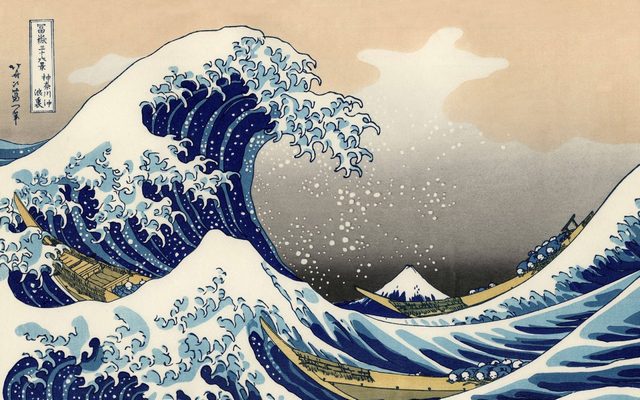TRAVELER’S DIARY:The Great Wave
Katsushika Hokusai’s “Under the Wave off Kanagawa”, also called “The Great Wave” has became one of the most famous works of art in the world and the most iconic work of Japanese art. Initially, thousands of copies of this print were quickly produced and sold cheaply. Despite the fact that it was created at a time when Japanese trade was heavily restricted, Hokusai’s print displays the influence of Dutch art, and proved to be inspirational for many artists working in Europe later in the 19th century. Is an ukiyo-e woodblock print published sometime between 1830-33. It was the first design for a series of originally “36 famous views of Mount Fuji”, Japan’s sacred mountain. The series was very successful in the market, and thus was later extended to 46 designs. The design shows a rather dramatic scene. A huge wave is swapping over three tiny, long and slim boats crammed with fishermen. Mount Fuji is peaking out in the background, very small and very calm and untouched by the drama unfolding in the sea a few dozen miles away. At first look, one thinks that the humans in their tiny boats are doomed to perish in the sea. However, they are probably not. The fishermen do not look panicked. On the contrary, they look like hanging to their rows in full discipline. It looks like they are experienced and know how to cope with such a situation. The waves come from the south, from the left in the image, it is traditional in Japanese painting that the sudden appearance of something extraordinary or unexpected is represented by an object depicted on the left or moving from left to right, as the eye proceeds from right to left, in accordance with Japanese writing. Hokusai makes the viewer experience tension and a strong sense of danger as the wave halts, frozen in time, above the boats. It is threatening, representing the awe of nature’s power. The balance between the water and other elements within the seascape emphasize the movement and a perfect balance between the authority and the beauty of nature. It is strange how although Hokusai presents a sea storm, the sun is still lighting up the sky. Ironically, despite this infamous piece epitomising Japanese art, its roots lie firmly in Western culture. Traditional Japanese artists would not have cared for painting low-class fishermen or nature, and would not have bothered with perspective. Hokusai resists such conventional Japanese methods, and instead seeks influence from Western Art. Hokusai was known by at least thirty names during his lifetime. He started painting at the age of 6, at the age of 18 he was accepted into the studio of Katsukawa Shunshō. Shunshō was an artist of ukiyo-e, a style of wood block prints and paintings that Hokusai would master, and head of the so-called Katsukawa school. Ukiyo-e, as practiced by artists like Shunshō, focused on images of the courtesans and Kabuki actors who were popular in Japan’s cities at the time. When Katsukawa Shunshō died in 1793, Katsushika Hokusai began experimenting with different kinds of art popular in Europe during that time. This form of art is later what led to his fame, but also got him expelled from the studio of Katsukawa Shunshō from his chief disciple. The images of his artwork had changed from that of popular courtesans and actors to daily life of the Japanese people and common Japanese images and landscapes. His medium changed to brush paintings instead of wood blocks, and thus beginning the height of his career, as well as another name change. Between 1814 and 1820, 12 collections of books put together known as manga were considered the precursors to today’s modern manga, the main inspiration behind comic book drawing. While these works of art were considered noteworthy in Japan during that era, he didn’t gain notoriety overseas until long after his death. In 1839, within a year of Hokusai’s death, a great fire destroyed his studio, and with it many of his life’s works. At this point in his career, his popularity had already begun to wane as he was replaced with other budding artists with different styles. He still continued to paint and improve in his craft until his death. He was quoted on his deathbed saying that ”If heaven would just give me ten more years, even just five more years, then perhaps I could become a real painter”. Info: Grand Palais, 3 Avenue du Général Eisenhower, Paris, Duration: 13-1/11/14, Hours: 12:30-19:00, www.grandpalais.fr/en – Dimitris Lempesis

